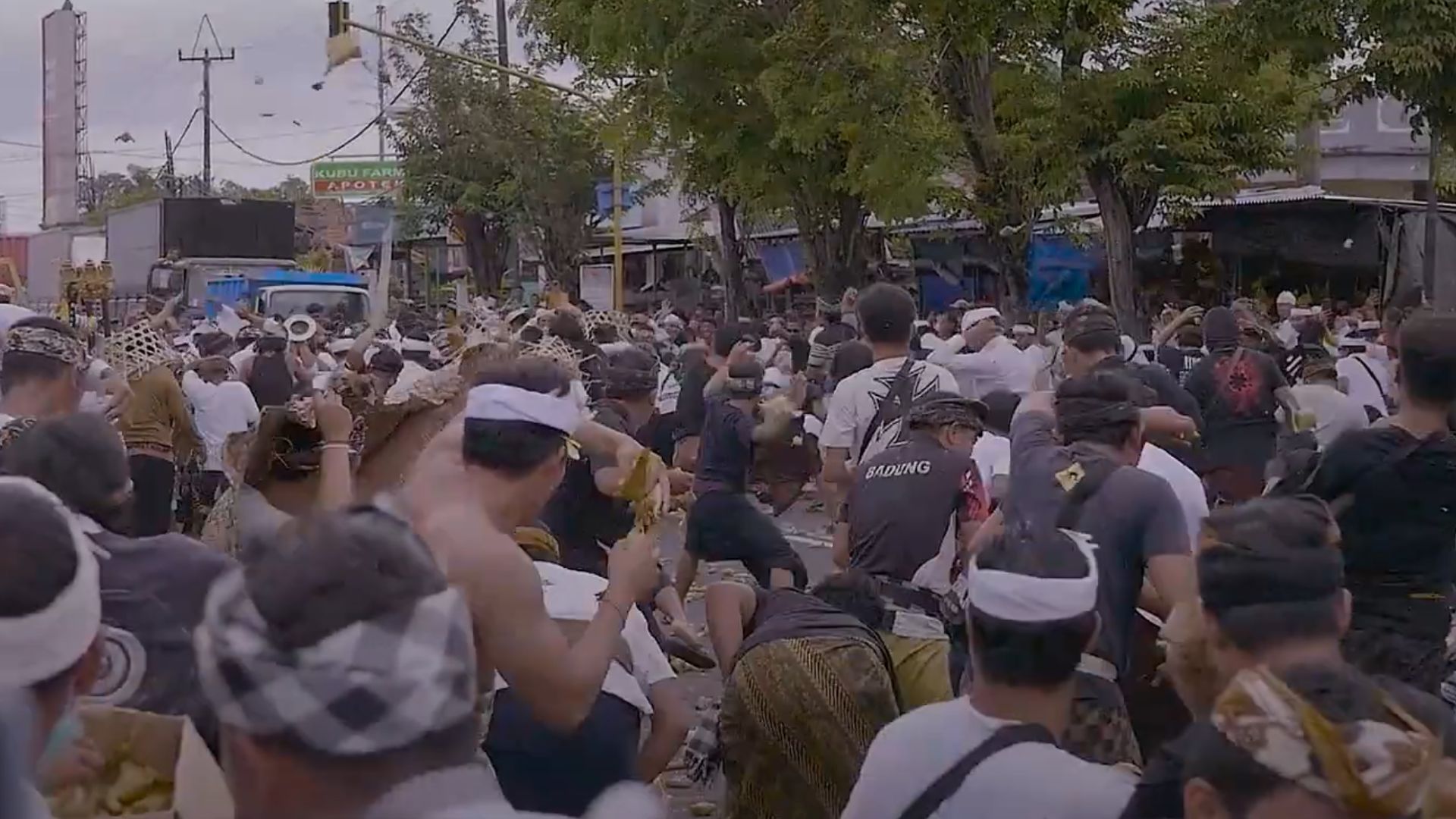General Questions
What is Siat Tipat Bantal?
Siat Tipat Bantal is a unique tradition exclusively found in Bali, specifically in Kapal Village, Mengwi District, Badung Regency. This “Siat” is often referred to as “tipat bantal war” because participants throw tipat (rice cakes wrapped in coconut leaves) and bantal (pillows made from woven coconut leaves) at each other. However, rest assured, this is not a real war! It’s all done as a symbolic prayer and hope for the village to be blessed with fertility, abundant harvests, and harmonious community life. This ritual also serves as a means to strengthen relationships among residents in a lively yet cohesive atmosphere.
Where is Siat Tipat Bantal held?
If you wish to watch or even experience the excitement of Siat Tipat Bantal, you must visit Kapal Village. This village is located in the Mengwi, Badung area. The event is typically held in the village’s main field or around the temple, which is the center of traditional activities. During the ceremony, the village atmosphere becomes very lively with local residents and curious tourists eager to witness this unique tradition firsthand.
When is Siat Tipat Bantal usually performed?
This ceremony is not held at all times. Siat Tipat Bantal usually takes place once a year, precisely during the full moon of Kapat according to the Balinese calendar. This typically falls around September or October in the Gregorian calendar. This time is chosen because it is believed to be perfect for seeking blessings from nature and abundant harvests. So, if you plan to attend, mark the date carefully so you don’t miss it!
Who participates in the Siat Tipat Bantal ritual?
Participants in Siat Tipat Bantal are usually the residents of Kapal Village themselves, especially the youth. They are divided into two opposing groups that enthusiastically throw tipat and bantal at each other. But even though it looks like a battle, there’s no resentment or anger. Everything is done with joy and laughter. In addition, many other residents attend as spectators, and even tourists are welcome to watch as long as they respect the prevailing customary rules.
Questions about Meaning & Philosophy
What is the meaning of tipat (rice cake) and bantal (pillow) in this ceremony?
In Siat Tipat Bantal, tipat (rice cakes) and bantal (pillows) are not just tools for throwing. Both have deep meanings closely related to nature and life. The square-shaped tipat symbolizes the female element or mother earth, while the oblong bantal symbolizes the male or sky father. When the two “clash” in this ritual, it signifies a hope for nature to be balanced, fertile, and full of blessings. So, tipat and bantal here are not just food or sleeping pillows, but carry a philosophy of harmony.
What is the purpose of holding Siat Tipat Bantal?
The main purpose of Siat Tipat Bantal is to seek blessings for fertile land, abundant harvests, and for the community to live in peace. This tradition is also a way for villagers to express gratitude for the blessings they have received, while also praying for continued good fortune in the future. Furthermore, Siat Tipat Bantal serves as a gathering place to strengthen the bond of brotherhood among villagers. Even though it looks like a “fight,” the atmosphere is filled with laughter and joy.
Why is Siat Tipat Bantal called a symbol of fertility?
This ceremony is referred to as a symbol of fertility because it conveys a message about the unification of two important elements: tipat as a symbol of the earth (female) and bantal as a symbol of the sky (male). This combination is believed to be a prayer for the universe to remain balanced and provide abundant harvests. The throwing of tipat and bantal is not just for fun, but carries the meaning of a request for the village to be blessed with rain, fertile land, and healthy plant growth.
What is the philosophy of “war” in Siat Tipat Bantal?
Although called “war,” Siat Tipat Bantal contains no element of hatred or animosity whatsoever. The philosophy of “war” here is more a symbol of a collective struggle to seek blessings and maintain harmony in life. Residents throw tipat and bantal at each other not out of anger, but as a form of togetherness and a prayer for all bad things to be dissolved and replaced with goodness and good fortune. “War” here signifies the spirit of communal cooperation in preserving culture and nature.
Questions about Implementation
How is the Siat Tipat Bantal performed?
The performance of Siat Tipat Bantal begins with a traditional ceremony at the temple, where residents pray together to ask for blessings from Ida Sang Hyang Widhi (God). After the prayers are complete, participants proceed to the field or temple yard, where the “tipat bantal war” takes place. There, they are ready with tipat (rice cakes) and bantal made from woven coconut leaves. The ritual proceeds with great enthusiasm, yet in a harmonious atmosphere. They throw tipat and bantal at each other, accompanied by the cheers and laughter of spectators. Everything is done joyfully, without any anger or hatred
What do participants do during the ceremony?
During the event, participants are divided into two opposing groups. Once the signal is given, they begin to throw tipat and bantal at each other. Don’t imagine the atmosphere is like a real war! Even though there’s throwing, everything is done with laughter and joy. Sometimes someone intentionally “gets hit” to add to the excitement. The point is, it’s not about winning or losing, but about togetherness and a shared prayer for the fertility of the village.
Are tourists allowed to watch or participate?
For tourists, don’t worry! The Siat Tipat Bantal ceremony is open for anyone to watch, including visitors from outside the village and even from abroad. However, direct participation in the throwing is usually reserved for local residents or those who have been granted permission by custom. So, tourists usually enjoy it as spectators and join in the euphoria and festive atmosphere of the event.
Are there any special rules for spectators?
Yes, even though the event is full of laughter and seems relaxed, there are some rules that spectators should follow. For example, do not disturb the ceremony, maintain respectful behavior, and avoid standing too close to the “war” area to avoid accidental throws. If you want to take photos or videos, make sure not to obstruct the ritual. Essentially, always respect local customs and culture so that everyone can enjoy the event comfortably.
Questions about History & Culture
What is the history or origin of Siat Tipat Bantal?
Speaking of its history, Siat Tipat Bantal has existed for a very long time, passed down through generations by the residents of Kapal Village, Bali. This tradition was born as part of a customary ceremony to ask for blessings from the Creator so that the village remains safe, fertile, and its residents prosperous. In the past, people believed that through this ritual, they could maintain harmony between humans, nature, and God. So, the tipat bantal war is not just an entertainment tradition, but carries spiritual and cultural values that are preserved to this day.
Is there a legend or folklore behind this tradition?
Behind Siat Tipat Bantal, there is also folklore that is often passed down through generations. It is said that this ritual was inspired by the story of two powerful figures who competed, but ultimately realized that it was better to live in harmony for the common good. The throwing of tipat and bantal became a symbol of the struggle towards peace and unity. This story further strengthens the meaning of the ritual, that the “war” here is not about animosity, but about collective effort for harmony and blessings.
What is the connection between Siat Tipat Bantal and agrarian traditions in Bali?
Siat Tipat Bantal is closely related to the agrarian life of the Balinese community. This ritual is held as a form of gratitude for the harvest and a prayer for the land to remain fertile, for abundant harvests, and for nature to be benevolent. This is because the majority of residents in the past (and even now) depended on farming for their livelihood. Therefore, Siat Tipat Bantal is not just an exciting event, but also has an important purpose: to ask nature to bestow blessings upon the rice fields, farms, and all the plants cultivated by the villagers.
Conclusion
Siat Tipat Bantal is not just a fun tradition of throwing tipat and bantal to watch. Behind it all lies a deep meaning related to the prayers, hopes, and gratitude of the residents of Kapal Village for God’s blessings. This ritual serves as a symbol of a plea for nature to remain fertile, for abundant harvests, and for residents to live in harmony. Tipat symbolizes mother earth, bantal symbolizes father sky, and when the two “clash,” it signifies their prayer for the balance of the universe. The performance is full of joy, and even though it is called a “war,” there is no anger or resentment whatsoever. Everything is done as a form of togetherness and to preserve the culture inherited from ancestors. Tourists are very welcome to watch, as long as they respect the existing customary rules. Besides being an interesting spectacle, Siat Tipat Bantal also reminds us of the strong connection between the Balinese community and nature and their agrarian traditions. This tradition also serves as proof that local wisdom continues to live and be preserved with great love to this day.












